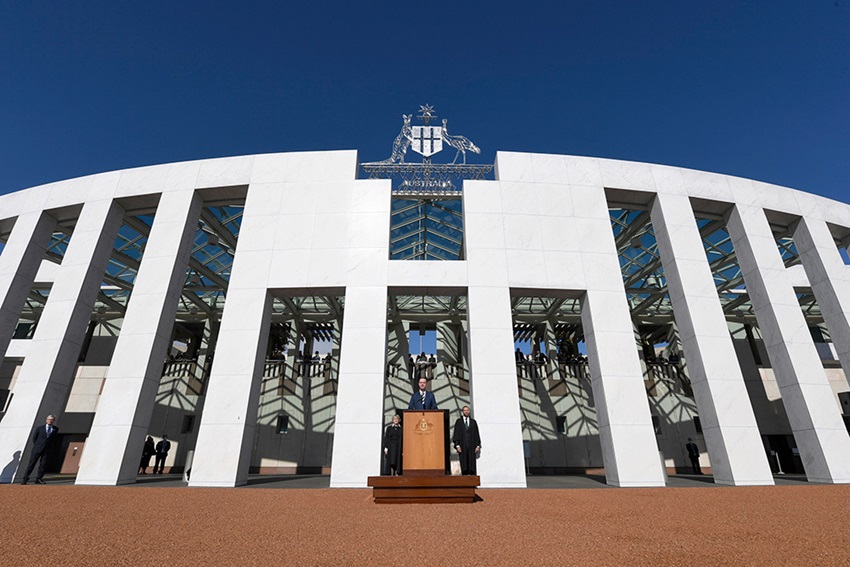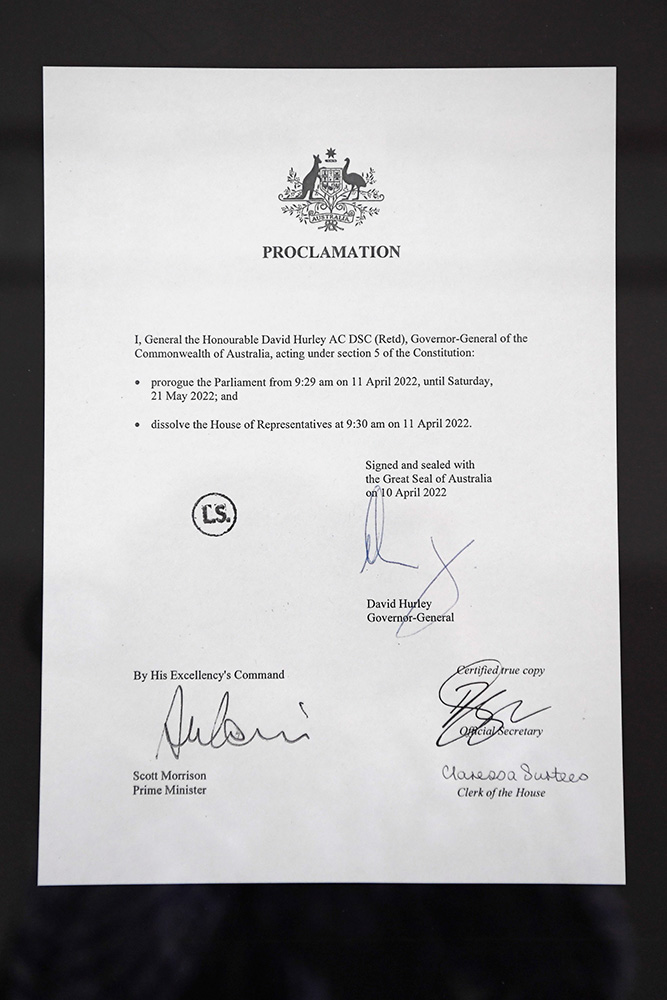31/05/2022
The Governor-General issued a proclamation on 10 April 2022 proroguing Parliament at 9.29am the following day and then dissolving the House of Representatives, ahead of a federal election on 21 May.

Official Secretary to the Governor-General, Mr Paul Singer MVO, Clerk of the House of Representatives, Claressa Surtees and Deputy Clerk Peter Banson walk through the Marble Foyer for reading of the Proclamation (photo: AUSPIC)
Section 5 of the Constitution gives the Governor-General the power to prorogue the Parliament, dissolve the House of Representatives and determine when the Parliament next meets. In practice the Governor-General acts on the advice of the Prime Minister.
The Senate has a continuing and rotating membership. This means that this election will comprise a half-Senate election along with a full House of Representatives election, as state senators are elected for 6-year terms and Members of the House are elected for three-year terms. The terms of territory senators run from one election to the next. The Senate’s rotational system strengthens the role of the Senate as a house of review as the Senate’s committees can continue to meet, conduct hearings and present reports if they resolve to do so up until the eve of the next Parliament.
How does the prorogation of Parliament affect the business of the Senate?
By ending the parliamentary session, prorogation terminates the sittings of the Senate and all business before the Senate so that it does not automatically carry over into the next session of Parliament. However, under Senate practice, business is deemed to remain on the Notice Paper (the Senate’s agenda) until immediately before the new session commences. Business terminated as a result of prorogation, including notices, bills and questions, may be restored or reintroduced in the new Parliament.

The Proclamation being read by Official Secretary to the Governor-General, Mr Paul Singer MVO outside Parliament House (photo: AUSPIC)
Notices: Senators who wish to pursue a notice of motion not reached before prorogation can lodge the notice again in the new Parliament.
Bills: In the new Parliament, senators can restore bills to the stage they reached in the previous Parliament or bills can be reintroduced afresh.
Questions on notice: The requirement to answer questions on notice lapses with the questions on the eve of the new Parliament. Replies received following prorogation will be provided to senators and published in the usual way. Senators who wish to pursue questions asked prior to prorogation which are not answered before the new Parliament commences, must resubmit those questions in the new Parliament.
Disallowance: The period of 15 sitting days for giving notices of motion to disallow legislative instruments continues to run from one Parliament into the next. Instruments which are the subject of unresolved disallowance motions at prorogation are deemed to be tabled again on the first sitting day of the next Parliament, so that the 15 sittings day period for giving a notice of motion to disallow them begins anew.
Documents: Documents, including Government documents, Auditor-Generalʼs reports and committee reports can be presented out of sitting following prorogation and will be published in the normal way. Orders for the production of documents are not affected by prorogation. If orders are complied with, documents will be received and published in the usual manner. Documents required to be tabled pursuant to statute (including disallowable instruments) may continue to be provided to the Clerk, and will be stockpiled for tabling in the new Parliament.

The signed Proclamation proroguing the Parliament and dissolving the House of Representatives (photo: AUSPIC)
Committees: Senate standing committees are appointed at the commencement of each Parliament and continue until the eve of the new Parliament. Most Senate committees are authorised to transact business after prorogation, so they may meet, conduct hearings and report if they resolve to do so. The orders requiring government responses to committee reports are still required to be provided post prorogation and continuing into the new Parliament. Of course, joint committees cease when the House of Representatives is dissolved.
Committees conducting estimates hearings can continue to meet and receive evidence after prorogation if they resolve to do so. Estimates questions on notice are regarded as continuing and departments and agencies should answer any questions outstanding at the time of the prorogation.
What's next?
The date set for the return of the writs after the election is 28 June 2022. Under section 5 of the Constitution, the Parliament must be summoned to meet within 30 days of that date. After the opening, Senate business will be full steam ahead again.
To find out more about prorogation see: